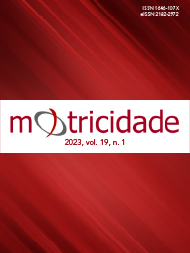Construction and validation of the instrument: checklist and risk assessment matrix (CMAR) in mountain sports
DOI:
https://doi.org/10.6063/motricidade.28118Keywords:
Instrument validation, Risk assessment, Checklist, Risk matrix, Risk factors, Mountain sportsAbstract
This study aims to develop and validate the checklist instrument and risk assessment matrix (CMAR) in mountain sports, namely hiking, canyoning, and climbing. The development of the CMAR was carried out through document analysis, literature review, and expert consultation. The content validation of the CMAR was done using the Delphi technique, involving 10 experts (aged: 35-58 years, 42.30±7.70 years; experience in the area: 17.00 ± 6.8 years), and the construct validation using exploratory factor analysis, involving 548 technicians and practitioners of hiking (n182), canyoning (n:183), and climbing (n:183). The 1st CMAR version proved to be relevant, clear and objective (ICCspecialists: 0.85-0.90) and included 51 items (risk factors) grouped into 3 dimensions. The final version of the CMAR included 36 items structured in 4 dimensions (human, materials and equipment, environmental, and safety and emergency), to be evaluated in a risk matrix of 5x5 points (probability x consequence), which leads up to a stratified risk level corresponding to a recommendation, action, and treatment (KMOmodel: 0.816; justified variance model: 56.4%). CMAR demonstrated good reliability and good-to-acceptable values for construct validation, enabling its use in risk analysis and management in mountain sports, such as hiking, canyoning, and climbing.
Downloads
Published
Issue
Section
License
The authors of submitted manuscripts must transfer the full copyright to Journal Motricidade / Sílabas Didáticas Editions. Granting copyright permission allows the publication and dissemination of the article in printed or electronic formats, and copyrights start at the moment the manuscript is accepted for publication. It also allows Journal Motricidade to use and commercialise the article in terms of licensing, lending or selling its content to indexation/abstracts databases and other entities.
According to the terms of the Creative Commons licence, authors may reproduce a reasonable number of copies for personal or professional purposes, but without any economic gain. SHERPA/RoMEO allows authors to post a final digital copy (post-printing version) of the article on their websites or on their institutions' scientific repository.


